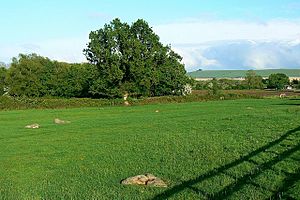Hodson Stone Circle facts for kids
Hodson Stone Circle was an ancient stone circle located in the village of Hodson in England. This circle was part of a big tradition of building stone circles across Britain, Ireland, and France (Brittany) a very long time ago. People built these circles during the Late Stone Age and Early Bronze Age, which was between 3300 and 900 BCE. We don't know exactly why these monuments were built. Some archaeologists think the stones might have represented special spirits or gods to the people who built them.
The Hodson Stone Circle was found and recorded by a man named A. D. Passmore in the 1890s. He wrote a little bit about it in a magazine and more details in his personal notebooks. He noted that the circle had eight stones. He also thought there might have been a path or line of stones leading from it towards another circle in Coate. Later, archaeologists noticed that some of the large stones (called sarsens) used in Hodson village might have once been part of this ancient circle.
What are Stone Circles?
Long, long ago, between 4000 and 2000 BCE, people in southern and eastern England started building different kinds of monuments. Before this, they built long burial mounds and large enclosures. But by 3000 BCE, they began creating circular monuments. These included earthen henges, timber circles (made of wood), and stone circles.
Stone circles are found in most parts of Britain where there are natural stones. They are especially common in southwestern Britain and northeastern Scotland. People built these circles for a very long time, possibly for 2,400 years, from 3300 to 900 BCE. The main period of building was between 3000 and 1300 BCE.
Archaeologists have found that these stone circles often show very few signs of people visiting them right after they were built. This suggests they might not have been used for noisy rituals that left many clues. Instead, they might have been "silent and empty monuments." Some archaeologists, like Mike Parker Pearson, believe that in ancient Britain, stone was connected to the dead, while wood was connected to the living. Others think the stones might have represented gods or other special beings, not just ancestors.
Many stone circles were built in the area of modern Wiltshire, where Hodson is located. The most famous ones are Avebury and Stonehenge. Sadly, most of the other circles in Wiltshire are now ruined or have been completely destroyed. Archaeologist Aubrey Burl noted that these destroyed circles have left behind "only frustrating descriptions and vague positions." Most of the Wiltshire circles were built in low-lying areas.
In the area south of Swindon, at least seven stone circles were once known to exist. They were often only a few miles apart. For example, the Fir Clump Stone Circle was just a mile south of the Broome Stone Circle. All of these northern Wiltshire circles have been destroyed. However, parts of one still remain: the stones at the Day House Lane Stone Circle in Coate, Swindon are still there, even though they have fallen over.
Finding the Hodson Circle
In 1894, a man named A. D. Passmore wrote an article in The Wiltshire Archaeological and Natural History Magazine. He mentioned that he knew of "a number of sarsens" (large stones) that he thought might have been part of a stone circle. He also noted that a line of stones seemed to come out from these and head towards Coate.
Passmore also kept two notebooks during that time. In these notebooks, he wrote more details about his discoveries. He noted that a road cut through the circle and several barns were built on top of it. This made the circle "very difficult to find." Passmore's notebooks and their notes about the Fir Clump Stone Circle were not published until 2004. This was after the Wiltshire Archaeological and Natural History Society bought them.
In his notebook, Passmore wrote that he found eight stones that were part of the circle. He also found three stones inside the circle. He thought these might have been part of an inner circle. If so, the Hodson Stone Circle would have had two circles, one inside the other, like the Day House Lane Stone Circle. Or, he thought, farmers might have just dumped the stones there to get them out of the way.
Passmore also guessed that the circle was about 250 feet (76 meters) across. This would make it similar in size to the Day House Lane Stone Circle. He identified "4 distinct lines of stone" coming out from the circle. He suggested that if these lines continued all the way to Coate, they might have connected to a line of stones he also thought came from the Day House Lane circle.
In their 2017 book about ancient Wiltshire, archaeologists David Field and David McOmish noted that a stone circle was "thought to have been present" in Hodson. They also suggested that any stones that were once part of it might now be found as loose sarsens around the village. Some might even be built into the walls of various buildings.


